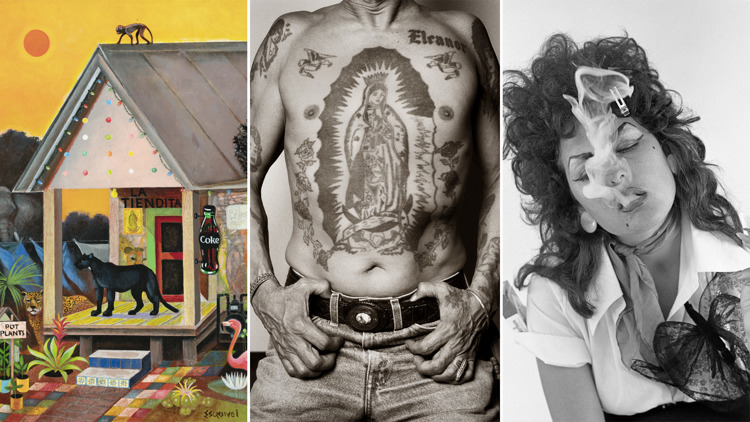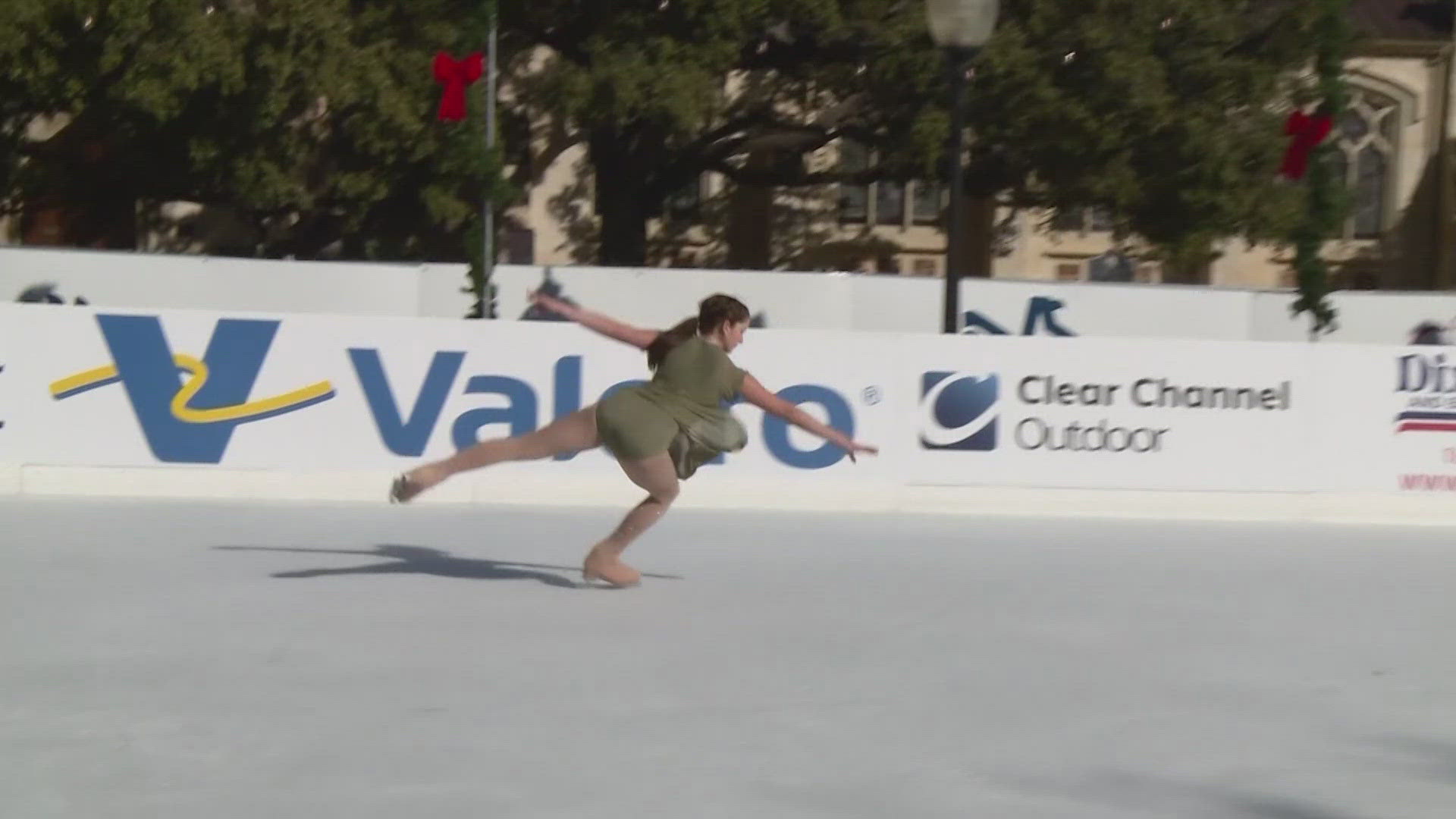SAN ANTONIO — An exhibit at the Contemporary at Blue Star highlights the past, present and future of Chicano and Chicana culture, right down to its modernized name: “Xicanx: Dreamers + Changemakers.”
Various art of all shapes, sizes and media types adorn the exhibit. On one wall near the entrance hangs a series of 1970s photographs that show pioneering Chicano artist Judith F. Baca assuming the personality of a Pachuca. Elsewhere, a slideshow of murals from the cities you’d expect (and some you wouldn’t) depict a kaleidoscope of Chicano/a identity. A few steps away, 100 digital portraits of people of color killed by law enforcement cover a wall and command your attention. Another large-scale installation underscores the reality of immigration by incorporating silhouetted images of a fleeing family against idyllic landscape paintings found in thrift stores.
All throughout, the exhibit takes the unorthodox step of accompanying each piece of art with words not from curatorial staff, but from the artists themselves. Most of them whose works make up “Dreamers + Changemakers” are from San Antonio.
Yet the exhibit didn’t originate here. It first graced the walls of the Museum of Anthropology at the University of British Columbia campus in Vancouver, more than 2,200 miles away.
“We would get goosebumps all the time when the work was really speaking to us,” said Mexico-based Greta de León, one of the exhibit’s organizers, about seeking art to feature in the show. “It was chemical, it was physical.”
The genesis for “Dreamers + Changemakers” goes back several years, to pre-pandemic times. Jill Baird, then a curator and the head of public programs for the Museum of Anthropology, sought to create a show spotlighting the Chicano experience—its indigenous roots, its evolution, its variety.
First came the research—an entire year of it, to be exact.
Then came collaboration. Baird enlisted the help of de León, executive director of The Americas Research Network, a “consortium of museums, universities and research institutions” started by the Smithsonian in 1998.
As it happened, de León herself lived in the Alamo City for about eight years in the '90s, when she was the Mexican Cultural Institute’s assistant director. That means she had some familiarity with San Antonio’s arts scene, and would be able to accompany Baird in studio visits and meetings through which the duo would hone in on the artists to invite and take part in “Dreamers + Changemakers.”
Those visits would happen in San Antonio. But not in other cities… not in-person, anyway. With the arrival of COVID, physical studio visits turned into virtual ones as Zoom quickly became part of the national lexicon.
“Curating in a pandemic, I guess the answer is: Yes, it’s possible,” Baird said. “Is it ideal? No.”
But planning and preparation for the exhibit pressed on. Part of Baird and de León’s objective was to capture the range of Chicano/a experience, meaning they would go to more than merely the dominant meccas of Latino culture.
Still, San Antonio artists would end up heavily featured in “Dreamers + Changemakers” when it opened in Vancouver in May 2022, kicking off an eight-month run and encompassing about 50 works of art. They picked their name with intention: Xicanx is a new term playing on Chicano/a that incorporated X to denote the exhibit’s indigenous roots as well as emphasizing the show's inclusiveness.
The museum also created a way to keep the exhibit running indefinitely—a digital catalog of that art and those artists, along with individual biography pages through which more of their work can be found.
“You also got a flavor of the artists from their other work, their food choices, their best books,” said Baird, who retired shortly after “Dreamers + Changemakers” debuted. “It was important to us that you really got a sense of the artists.”
But the team behind the exhibit felt its physical iteration still had life to it. To Baird and de León, it only made sense to eventually bring it to San Antonio.
On the move
Jon Hinojosa knows a thing or two about the power of art in the community.
A resident of San Antonio for nearly 40 years, Hinojosa up until 2023 was the artistic and executive director of SAY Sí, an arts education program that services thousands of Alamo City students. The gig put him in close contact with local artists and scholars, one of whom teaches at UTSA and told Hinojosa about “Dreamers + Changemakers,” connecting him with de León.
The two chatted about the Vancouver exhibit, and an idea took hold.
“She goes, ‘You know, this exhibit has to come to San Antonio,’” Hinojosa said. “‘Wouldn’t it be great if you showcased it at your organization?’”
He agreed, but their early desires to bring it to SAY Sí’s facility fizzled.
Instead, Hinojosa started talking to staff at an institution he knew had experience hosting sizeable art shows: Contemporary at Blue Star.
“We jumped at the opportunity,” says Jacqueline McGilvray, Contemporary’s curator and exhibitions director.
“She looked at things and tweaked some things, and she came back to me and she goes, ‘Let’s figure out how to get this done,’” Hinojosa added.
A venue fit for a showcase as wide-ranging as “Dreamers + Changemakers” was secured, and funds awarded by the Texas Commission on the Arts and National Endowment for the Arts make its relocation feasible from a financial standpoint.
But the Contemporary is a smaller space than the Museum of Anthropology’s halls in Vancouver, so bringing the show to San Antonio meant not only downsizing it slightly but also “remapping” the exhibit’s design and layout.
Baird and de León reunited to make the dream a reality, teaming up once again with original exhibit designer Skooker Broome. The Contemporary was all in as well, even undertaking new wall construction to allow for more pieces to be exhibited and to retain the spirit of the Vancouver show, according to McGilvray.
The show opened in May 2024, a condensed but no less impactful version of the exhibit previously on display in Canada. It runs through Oct. 6.
“We were so pleased and thankful that it was coming to San Antonio,” Baird said. “We felt a really big responsibility to make sure the San Antonio artists were featured well, that their work looked fantastic.”

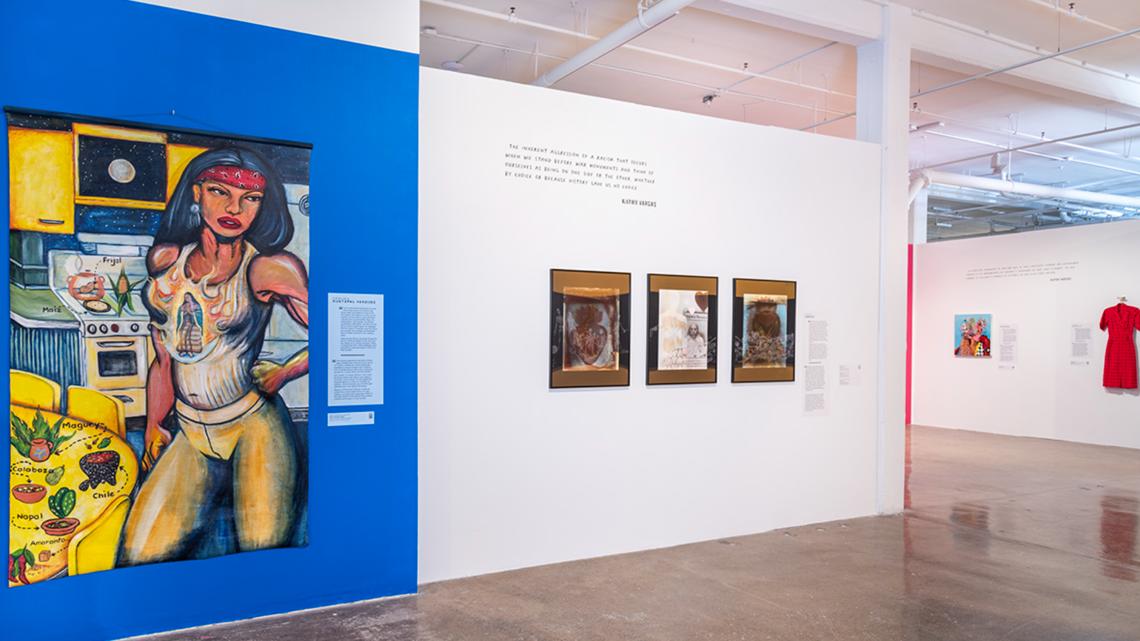
The man who played a role in bringing “Xicanx: Dreamers + Changemakers” to Texas, meanwhile, saw in it even more potential for the community and those who love art of any kind. Hinojosa repurposed that drive that propelled him for so many years at SAY Sí, putting his contacts to good use to create what he believes is the city’s first monthlong, organized celebration of Chicano/a culture and history.
The name he gave it was an apt one: Xicanx Month.
“There are young, third-, fourth-, fifth-generation Mexican Americans in this city that don’t know this history,” Hinojosa said. “This was an opportunity to provide educational initiatives.”
Comprised of about two dozen events that took place in August, Xicanx Month involved small San Antonio organizations and major institutions, from Ruby City and the McNay to the Agarita chamber ensemble and the San Antonio River Foundation.
Some of those events ended up being standing-room only, and Hinojosa is already using that success to plan next year’s iteration while recognizing it’s all about sharing experiences that make up the fabric of the city.
“Every day of the year is Chicao Month in San Antonio, because that’s the history and the love.”
‘We’re just housekeeping’
One of the most important things for de León and Baird was embracing their roles in such a way that their voices didn’t dominate “Dreamers + Changemakers,” hence the minimal curatorial text to make space for artists to express themselves.
“This is us setting the table, putting out the microphone for people to speak about their own personal experience,” de León said. “We’re just housekeeping it.”
They were, in other words, presenting the artists how they wanted to be presented. As they put it, it was their way of pushing back against Chicano/a erasure.
That objective resonated with Celeste de Luna, a San Antonio-based printmaker from the Rio Grand Valley who was not only featured in the Vancouver show, but traveled to see it herself.
“I thought, ‘That’s really cool that they’re acknowledging other indigenous people in America,’” de Luna said. “It might have been like (they were saying), ‘Take a note. This work is important, the people are important.’”

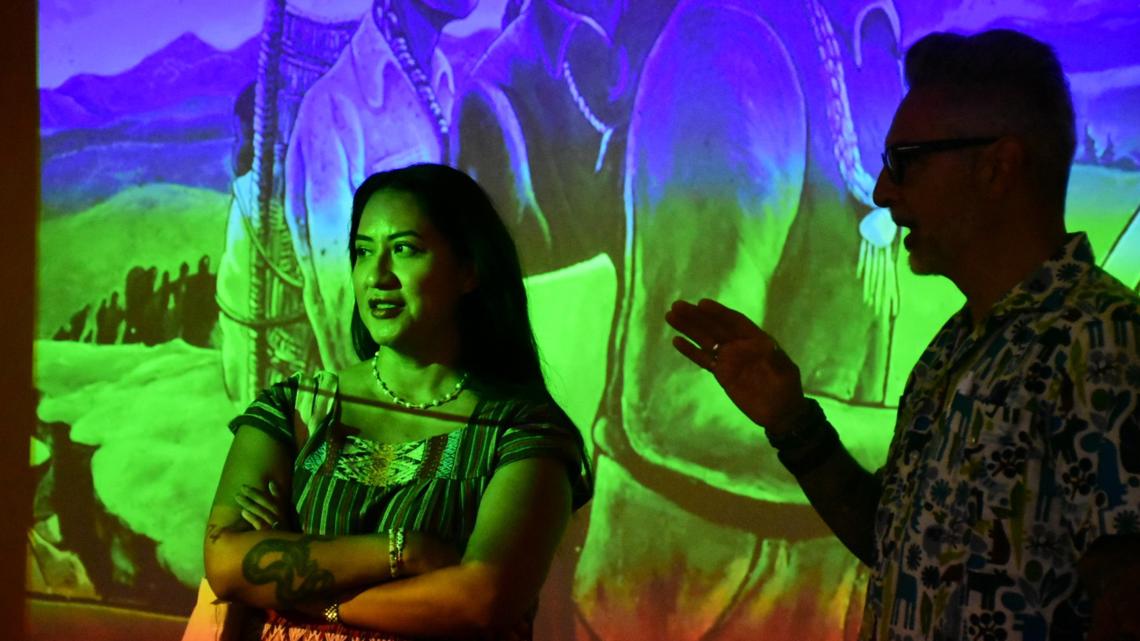
De Luna’s piece currently featured at the Contemporary is called “Our Lady of the Checkpoint,” and takes after much of her work in its blend of borderland elements and religious iconography. It depicts, in striking fashion, a cloaked migrant appearing like a spectral echo of the Virgin of Guadalupe, walking toward the viewer from a border checkpoint made to resemble an altar.
Having spent her formative years in the RGV, de Luna said she started exploring Chicano themes and her environment through art while in graduate school. It was key to her navigating her identity.
“When you don’t know a lot about yourself and you make artwork that is trying to figure it out, you discover things about yourself. You and your audience are finding out new things about yourself at the same time. It’s invasive,” she said, laughing.
The environment and its political implications also inform the work of Ricky Armendariz, another featured artist in “Dreamers + Changemakers” who is originally from El Paso. His piece “Agua mi Vida” depicts a water jug like a mirage, suspended over moonlight-draped desert.
The work is magnetic but the inspiration is tangible for Armendariz, who said he would often see jugs placed in the El Paso desert by humanitarians wanting to help thirsty migrants.
“I don’t go, ‘Ok, I’m making work about the border,’” Armendariz said. “I just make work and it always creeps in.”
The longtime painter and printmaker said he was “over the moon” to be included in the lineage of Chicano art explored through the exhibit, alongside the likes of Cecilia Muñoz, Carlos Fresquez and Rolando Briseño. While walking through the exhibit, he’s eager to point out not just what pops out to him in other art pieces, but the different styles, techniques and tones that prove the exhibit’s point: There isn’t one thing or piece or artist that defines Chicano art.

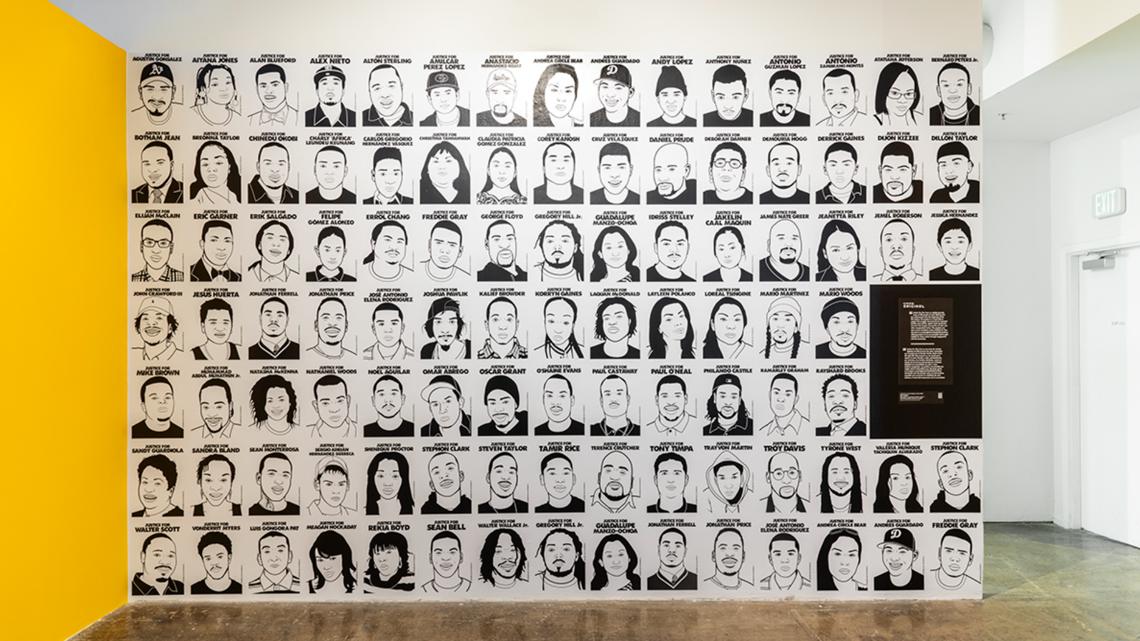
Armendariz is also an art professor at UTSA and says he planned to bring his class to the Contemporary, to give them a firsthand look at the breadth of art by Chicano artists on display through photos and fabrics, paints and stencils, watercolors and mixed media.
“It speaks to the fact we’re so diverse as a community,” he said. “I heard that there was a large contingency of Latinos in Vancouver. And that’s our story—we’re everywhere.”
De León acknowledges that diversity too, but in the context of the Alamo City’s arts scene itself. Bringing “Dreamers + Changemakers” here brought things full circle for this one-time San Antonian.
And after conducting the only in-person studio visits for the original Vancouver show in San Antonio, she was finally able to return with Baird, for a June event, to the community she calls “one of the most culturally creative cities I know.”
“It’s incredibly resilient,” de León said. “It is their adaptability, and also the way they’ve endured to dealing with outsiders becoming part of the community. It’s an incredibly diverse tapestry, it’s vibrant, it’s productive. It just breeds creativity.”


